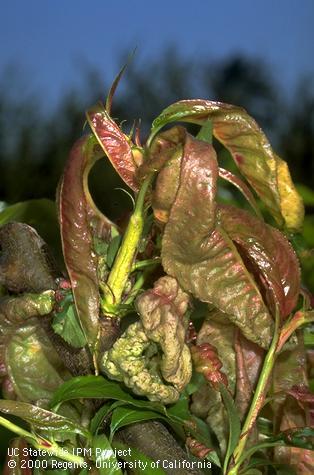
Copper sprays can be effective if applied during dormancy

|
|
Distorted and blistered leaves are signs of peach leaf curl.
Now is the time to spray peach and nectarine trees to control it. (Photo courtesy UC Statewide Integrated Pest Management) |
It may be Thanksgiving, but it’s time to talk peaches. In particular, this conversation is about peach leaf curl.
This common fungal disease only attacks peach and nectarine trees. It distorts and puckers foliage and new shoots. It can completely defoliate a tree, leaving any developing fruit to sunburn or shrivel. Over time, it greatly cuts down on a tree’s productivity.
And it comes back, year after year after year. Once it’s established, peach leaf curl will be an issue every spring.
The time to combat this fungus is not when you see its damage in April or May; it’s now, in the days before and after Thanksgiving.
To control leaf curl, peach and nectarine trees benefit from dormant spraying with a copper fungicide or copper soap. Horticultural oil helps make that copper spray stick to the twigs and branches.
According to the UC Integrated Pest Management Program, the copper spray smothers the fungal spores that overwinter on the tree.
“The fungal spores that cause the disease spend the winter on twigs and buds and germinate in the spring,” say the IPM experts. “For effective control, treat trees just after leaves have fallen, usually late November or December.
"A second application in late winter before buds swell can be considered, especially in areas with high rainfall or during wet winters. Don’t apply fungicides during the growing season because they won’t be effective.”
A dry, calm and fogless almost-winter day; that’s the perfect time to spray. And that’s also the forecast for the greater Sacramento area this Thanksgiving weekend and early next week. Copper sprays need 24 hours of dry, calm weather before and after application. This is a good window of spraying opportunity.
If needed, prune before spraying. Pick up any dropped foliage and discard (don’t compost). Those fallen leaves may carry leaf curl, too.
For more on treating peach leaf curl: http://ipm.ucanr.edu/QT/peachleafcurlcard.html
Comments
0 comments have been posted.Sacramento Digs Gardening to your inbox.
Food in My Back Yard Series
April 22: Should you stock up on fertilizer? (Yes!)
April 15: Grow culinary herbs in containers
April 8: When to plant summer vegetables
April 1: Don't be fooled by these garden myths
March 25: Fertilizer tips: How to 'feed' your vegetables for healthy growth
March 18: Time to give vegetable seedlings some more space
March 11: Ways to win the fight against weeds
March 4: Potatoes from the garden
Feb. 25: Plant a fruit tree now -- for later
Feb. 18: How to squeeze more food into less space
Feb. 11: When to plant? Consider staggering your transplants
Feb. 4: Starting in seed starting
Sites We Like
Garden Checklist for week of April 27
Once the clouds clear, get to work. Spring growth is in high gear.
* Set out tomato, pepper and eggplant transplants.
* From seed, plant beans, beets, cantaloupes, carrots, corn, cucumbers, melons, pumpkins, radishes and squash. Plant onion sets.
* In the flower garden, plant seeds for asters, cosmos, celosia, marigolds, salvia, sunflowers and zinnias. Transplant petunias, zinnias, geraniums and other summer bloomers.
* Plant perennials and dahlia tubers for summer bloom. Late April is about the last chance to plant summer bulbs, such as gladiolus and tuberous begonias.
* Transplant lettuce and cabbage seedlings.
* Weed, weed, weed! Don’t let unwanted plants go to seed.
* April is the last chance to plant citrus trees such as dwarf orange, lemon and kumquat. These trees also look good in landscaping and provide fresh fruit in winter.
* Feed citrus trees with a low dose of balanced fertilizer (such as 10-10-10) during bloom to help set fruit. Keep an eye out for ants.
* Apply slow-release fertilizer to the lawn.
* Thoroughly clean debris from the bottom of outdoor ponds or fountains.
* Start thinning fruit that's formed on apple and stone fruit trees -- you'll get larger fruit at harvest (and avoid limb breakage) if some is thinned now. The UC recommendation is to thin fruit when it is about 3/4 of an inch in diameter. Peaches and nectarines should be thinned to about 6 inches apart; smaller fruit such as plums and pluots can be about 4 inches apart. Apricots can be left at 3 inches apart. Apples and pears should be thinned to one fruit per cluster of flowers, 6 to 8 inches apart.
* Azaleas and camellias looking a little yellow? If leaves are turning yellow between the veins, give them a boost with chelated iron.
* Trim dead flowers but not leaves from spring-flowering bulbs such as daffodils and tulips. Those leaves gather energy to create next year's flowers. Also, give the bulbs a fertilizer boost after bloom.
* Pinch chrysanthemums back to 12 inches for fall flowers. Cut old stems to the ground.
* Mulch around plants to conserve moisture and control weeds.